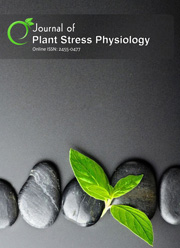Growth and biomass yield responses of Sphenostylis stenocarpa (Hochst. Ex A. Rich.) Harms accessions to waterlogging stress
DOI:
https://doi.org/10.25081/jpsp.2024.v10.8715Keywords:
African yam bean, Photosynthetic pigment, Stress, Sphenostylis stenocarpa, WaterloggingAbstract
Effects of waterlogging on the growth of six accessions of Sphenostylis stenocarpa were investigated. There accessions were TSs-5, TSs-7, TSs-8, TSs-9 TSs-10 and TSs-11. After growing S. stenocarpa for 4 weeks, results indicated that waterlogging significantly (p=0.05) reduced its growth parameters of S. stenocarpa. For shoot length; TSs-9 recorded the highest value (48.27±2.92 cm) above its control while TSs-11 (17.96±1.13 cm) had the lowest value. For petiole length, TSs-9 (3.62±0.33 cm) recorded the highest value while TSs-8 (0.93±0.93 cm) recorded the lowest value. Internode length had TSs-7 (6.10±0.78 cm) had the highest value while TSs-8 (2.87±2.87 cm) had the lowest value. The total photosynthetic pigment measurement showed that TSs-5 (45.0±0.65 mg/kg) with the highest value and TSs-8 (33.37±14.00 mg/kg) had the lowest value. For leaf area, TSs-7 (25.73±4.21 cm2) had the highest value while TSs-11 (16.13±2.82 cm2) recorded the lowest value. Total Fresh Weight (TFW), TSs-7 recorded the highest value (4.96 g) while TSs-8 recorded the lowest value (1.75 g). Root Fresh Weight (RFW), Tss-5 was observed to have the highest value (1.44 g) while Tss-11 recorded the lowest value (0.56 g). However, at 2 weeks after planting the effect of waterlogging stress on the growth parameter was not significant. The reduction in the growth of S. stenocarpa as a result of waterlogging stress might be due to the detrimental effect of flooding on O2 availability for plant cells and other plant metabolic activities of the plant. In areas with waterlogged soil conditions, S. stenocarpa should not be cultivated as it has poor and relatively low tolerance towards withstanding the impact of waterlogging; however, accession TSs-9 showed promising waterlogging tolerance ability.
Downloads
References
AOAC. (2005). Official method of Analysis. (18th Ed.). Association of Officiating Analytical Chemists, Washington DC.
Armstrong, W., Brändle, R., & Jackson, M. B. (1994). Mechanisms of flood tolerance in plants. Acta Botanica Neerlandica, 43(4), 307-358. https://doi.org/10.1111/j.1438-8677.1994.tb00756.x
Ashraf, M. A. (2012). Waterlogging stress in plants: a review. African Journal of Agricultural Research, 7(13), 1976-1981. https://doi.org/10.5897/AJARX11.084
Bailey-Serres, J., & Voesenek, L. A. C. J. (2008). Flooding stress: Acclimations and genetic diversity. Annual Review Plant Biology, 59, 313-339. https://doi.org/10.1146/annurev.arplant.59.032607.092752
Bange, M. P., Milroy, S. P., & Thongbai, P. (2004). Growth and yield of cotton in response to waterlogging. Field Crops Research, 88(2-3), 129-142. https://doi.org/10.1016/j.fcr.2003.12.002
Chude, V. O., Olayiwola, S. O., Osho, A. O., & Daudu, C. K. (2011). Fertilizer use and management practices for crops in Nigeria. (4th ed.). Abuja, Nigeria: Federal Fertilizer Department, Federal Ministry of Agriculture and Rural Development.
FAO. (1976). A framework for land evaluation. FAO Soil Bulletin No. 32. FAO, Rome.
FMANR. (1999). Evolving an effective agricultural land policy for Nigeria. Federal Ministry of Agriculture and Natural Resources.
FPDD. (1989). Fertilizer use and management practices for crops in Nigeria. Federal Ministry of Agriculture, Water Resources and Rural Development, Lagos.
Gambrell, R. P., & Patrick, W. H. (1978). Chemical and microbiological properties of anaerobic soils and sediments. In D. D. Hook & R. M. M. Crawford (Eds.), Plant life in anaerobic environments (Vol. 3, pp. 375-423) Ann Arbor, Michigan: Ann Arbor Science Publishers.
Gibbs, J., & Greenway, H. (2003). Mechanisms of anoxia tolerance in plants. I. Growth, survival and anaerobic catabolism. Functional Plant Biology, 30(3), 353. https://doi.org/10.1071/PP98095_ER
Kozlowski, T. T., & Pallardy, S. G. (1997). Physiology of woody plants. Academic Press, San Diego, California.
Martínez-Alcántara, B., Jover, S., Quiñones, A., Forner-Giner, M. A., Rodríguez-Gamir, J., Legaz, F., Primo-Millo, E., & Iglesias, D. J. (2012). Flooding affects uptake and distribution of carbon and nitrogen in citrus seedlings. Journal of Plant Physiology, 169(12), 1150-1157. https://doi.org/10.1016/j.jplph.2012.03.016
McNamara, S. T., & Mitchell, C. A. (1989). Differential flood stress resistance of two tomato genotypes. Journal of the American Society for Horticultural Science, 114(6), 976-980. https://doi.org/10.21273/JASHS.114.6.976
Taiz, L., & Zeiger, E. (2010). Plant physiology. (5th ed.). Sunderland, Massachusetts: Sinauer Associates Inc.
Tisdale, S. L., Nelson, W. L., Beaton, J. D., & Havlin, J. L. (1993). Soil fertility and fertilizers. (5th ed.). New York, US: Macmillan publication Company.
Uduak, I. G., Akpan, E. A., Ekong, U. J., Ekwere, O. J., & Enyong, J. K. (2014). Fertility status and problems of Cross River floodplain soils. In Proceedings of the 38th annual conference of Soil Science Society of Nigeria (SSSN) (pp. 460-467).
Wu, Y.-S., & Yang, C.-Y. (2016). Physiological responses and expression profile of NADPH oxidase in Rice (Oryza sativa) seedlings under different levels of submergence. Rice, 9, 2. https://doi.org/10.1186/s12284-016-0074-9
Published
How to Cite
Issue
Section
Copyright (c) 2024 Journal of Plant Stress Physiology

This work is licensed under a Creative Commons Attribution 4.0 International License.



 .
.